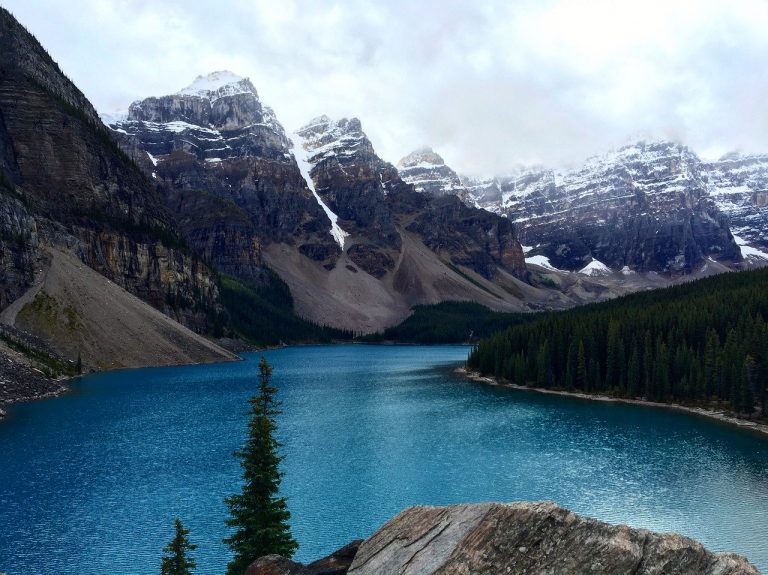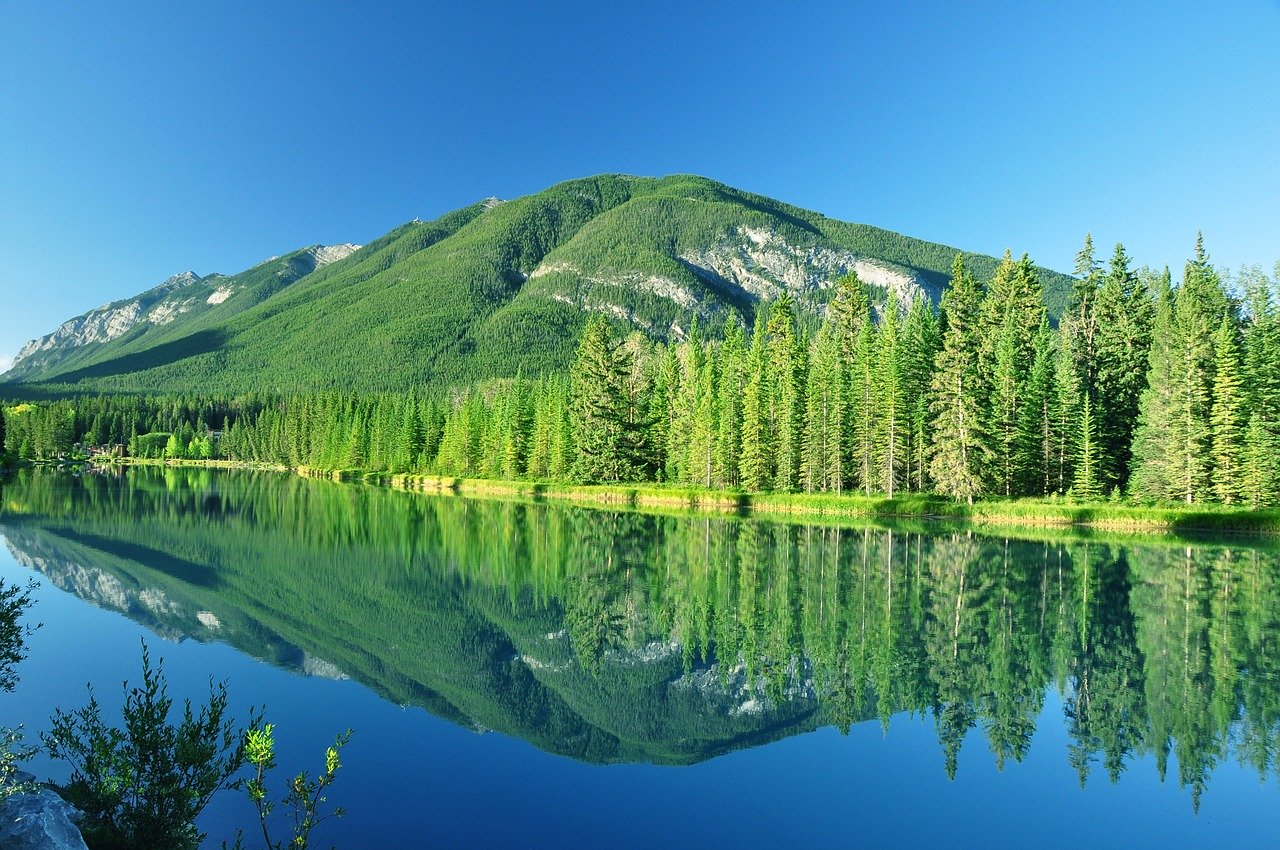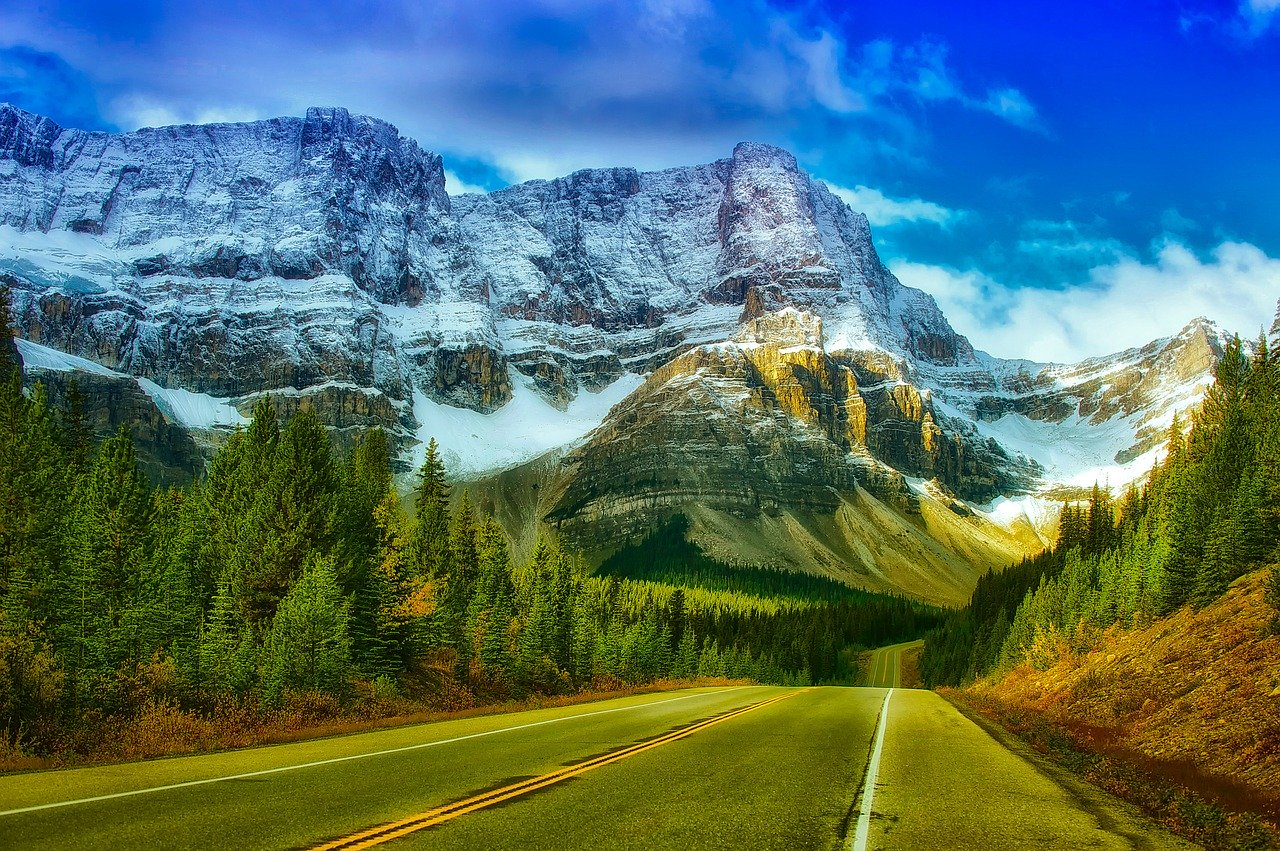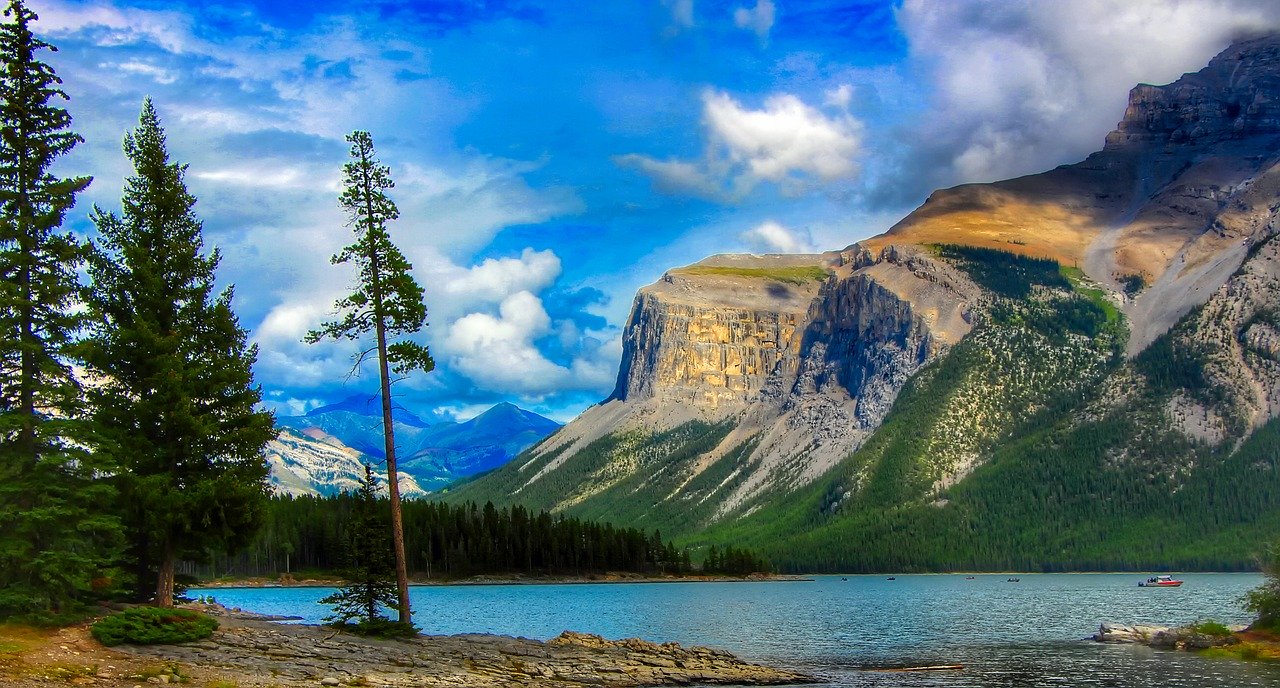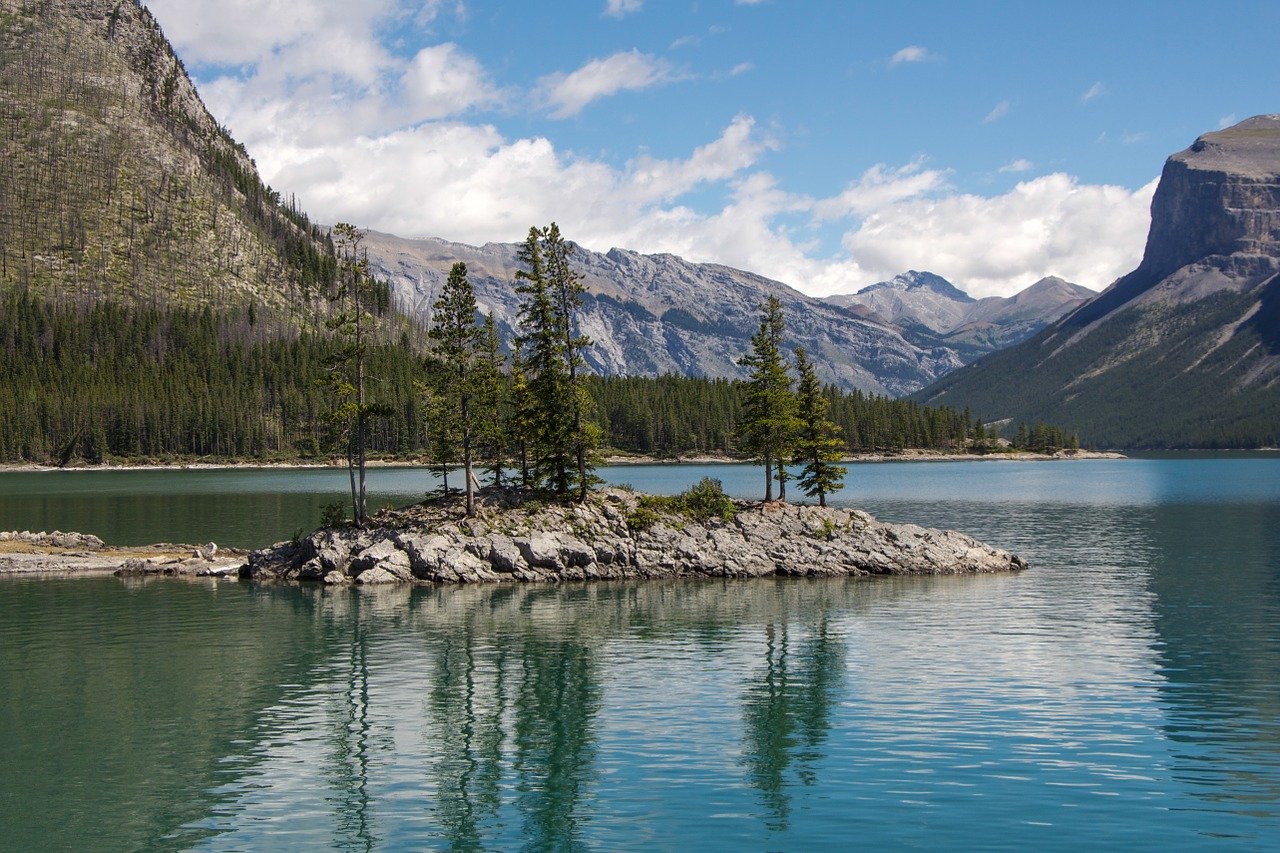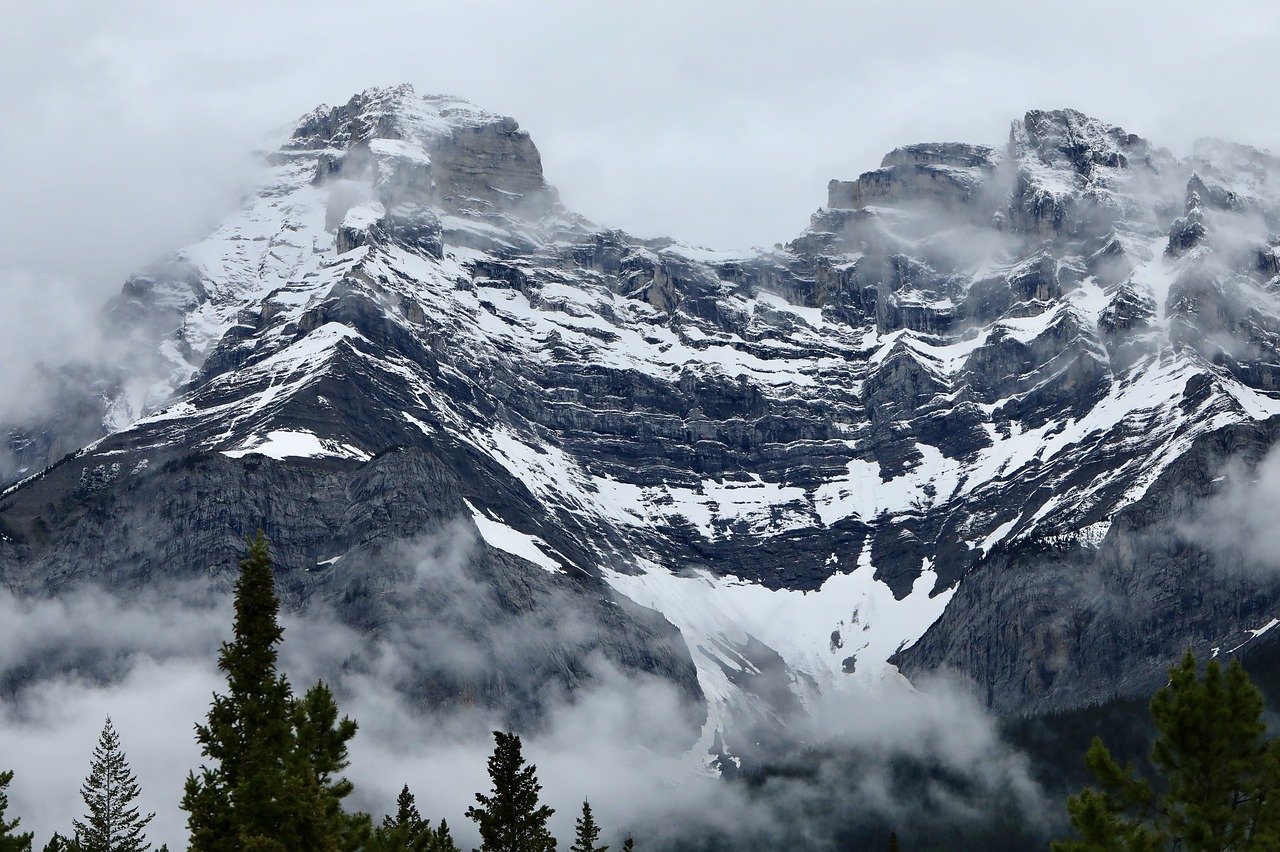Banff National Park is one of the most beautiful parks you will find in Canada. It is a national park and it can be found along the Alberta-British Columbia border about 1 and 1/2 hours from Calgary.
The park offers plenty of greenery, natural beauty in the form of mountain peaks, plenty of diverse wildlife, many hiking trails, stunning lakes, and the unique town of Banff with plenty to do and see. The atmosphere you will find there is one of a kind and it is very peaceful. It makes the park one of the best places to visit in Canada.
Where Is Banff National Park?
You will find this park which was established in 1885 located in the Rocky Mountains. It is around 110 to 180 kilometers towards the west of Calgary and it features a whopping 6,641 square kilometers of hilly terrain.
Closest Airport To Banff National Park
For the majority of people traveling to the park, the best way to reach Banff would be to head to the closest airport.
By flying to Calgary, you should be able to reach it much easier. You will find a lot of different connections from within the country and you will find a lot of connections from regional hubs scattered throughout the United States.
Once you reach your destination, you can prepare for a 90-mile drive to the park. You could also consider taking an airport shuttle to reach it.
Banff National Park Weather
December – March
While you can expect snow to continue falling just about every month, you will find the months from December to March to be the heaviest. That is why the majority of skiers travel during this period. You will find the temperatures throughout the day rarely surpassing 32 degrees Fahrenheit until the mid-portion of March.
You can also expect the night time temperatures to be around 0 degrees at night during these times. You will find that temperatures tend to change very quickly and that the temperatures can vary in a big way in the various mountains.
You should be looking to secure a hotel early when you are planning on traveling during this peak season. Likewise, you should attempt to avoid holidays if you are traveling without looking to spend a lot. If you are aiming to see a lot of the top sites, you will want to avoid this time period because a lot of the roads leading up to them are closed for avalanche season.
April – May
This is an interesting time period for the Banff National park. You will find weather ranging from hazardous blizzards to warm temperatures. While you can find Spring temperatures reaching as high as the mid-50s, you can’t expect anything. You will be in for a surprise no matter what when you travel during the Spring.
If you are going to the park to spot a lot of the wildlife, you will want to head to the park around late Spring to early Summer. You will find the Columbia Icefield to begin accepting visitors around mid-April.
June – August
This is typically when you will find the most crowds at the park. This is the time period in which the temperature is the warmest with the average highs sitting in the low 70’s.
However, warm weather isn’t the only reason you should be looking to travel to Banff National park during this time. It’s also because it is when the lakes look their best.
If you head to the park at any other time of the year, you can expect the lake to be frozen over. Likewise, you can book a hotel which will give you plenty of access to some of the best hiking and biking around.
September – November
While you will find September being the height of the Fall season, you will find October getting extremely cold very fast. In fact, blizzards can begin happening as early as October.
However, if you are someone who is not afraid of the cold, you will find a lot to do during this time period as November is the start of the ski season.
Best Time To Visit Banff National Park
There is no doubt, the best time period to visit Banff would be anytime between June through August. You can also visit from December through March. Typically those who are looking to spend more time outdoors are going to want to wait for the warmer temperatures.
However, the people looking to ski are likely going to want to stick to venturing out when the temperatures are the coolest.
Thus, it can depend on what you are going there to do. No matter when you end up choosing to visit, you should be bringing a hat, sunglasses, and sunscreen because you will find the sun at these higher altitudes to be very strong.
Things To Do In Banff National Park
Lake Louise
The beautiful Lake Louise is the true jewel of the region of the Banff National Park.
Come winter, this area also becomes a ski resort, North America’s largest, and is one that is very popular with not only snowboarders and skiers but also those wanting to try other winter sports, like tubing, dog sledding, and snowshoeing. Your horse-drawn sleigh ride can be a truly magical experience.
And in summer, the lake becomes even more spectacular, when approached through the biking and hiking trails, that offer you scenic views of the towering Canadian Rockies.
Moraine Lake
Moraine Lake is just one more of the famous lakes in Banff National Park, situated in the Ten Peaks rugged valley. This body of water is entirely fed by water from a glacier and is a spot that is a highly popular photographic spot in Banff, with its turquoise blue waters that are a fantastic bright shade.
All around the lake area are many biking and hiking trails, that allow you to witness the view of the lake, also called the “Twenty Dollar View”, because it appeared on Canadian twenty-dollar bills issued between 1969 and 1979.
Canadian Rockies Whyte Museum
The Whyte Museum acts to serve as a great introduction to the area’s visitors, especially about the history of the Rockies and the people who inhabited this area over the years. Water is a natural resource that has always been important throughout civilization, and the exhibitions in the museum are mostly related to this.
Banff Gondola
You can experience the impressive views of this area, in a most relaxed way if you opt for the Banff Gondola.
You need to go just 5 minutes out of Banff to allow the gondola to take you to an observation point that is 2281m or 7484ft above sea level and overlooks six mountain ranges as well as the Bow Valley.
Bow Falls
Head to Bow Falls, if you want to avoid crowds, but you will need to go on a hiking trail that is particularly arduous so that you can appreciate the natural beauty of Banff.
It is an area that is popular with film fans as they recognize it from its appearance in Hollywood movies, like the “River of No Return”, that starred Marilyn Monroe.
Banff Centre
A cultural venue in the region, the Banff Centre for Arts and Creativity, was founded in 1933 to serve as an intersection between the arts and ideas. The center’s innovative programs inspire its visitors to unleash any creative potential that they have.
Keep an eye on its website, so that you do not miss the many events, that include dance, music, film and theatre performances, and also information about the schedule of the annual festivals program, especially the Banff Mountain Festival and the Banff International String Quartet Competition that celebrates film and local literature.
Columbian Icefields
The largest icefield at one place, the Columbian Icefields, are situated in northwestern region of the Banff National Park. A 90-minute tour “Glacier Adventure” is offered by Brewster Adventures in which a vehicle of special design takes you on a drive of the icefield’s surface and disembarks you directly on to one of the world’s most accessible glacier, the Athabasca Glacier.
There is the Columbia Icefield Glacier Discovery Centre that has a factual display on the history of the glacier, plus a 1km skywalk with a glass bottom, that allows you incredible views of the area 280m below.
Upper Hot Springs Pool
At over 5000 feet (1524m), and nestled in the Rocky Mountains are the Banff Upper Springs, the highest naturally occurring hot mineral springs in Canada. There are amenities here that you will find in an outdoor spa, in this natural pool that was first discovered in 1883 and has a natural heat that is near to 40C or 104F.
The springs can give you a relaxing and invigorating experience, especially in the quieter morning hours when the atmosphere is peaceful and allows you to enjoy the scenery surrounding you as you look across the Mount Rundle valley.
Cave And Basin National Historic Site
In 1883, after three railway workers came across this cave and the hot springs in it, it led to the founding of the national park system of Canada ad also led to the site being one of the most significant landmarks in the country.
There are a series of interactive exhibits here that will give you more information that include a visual expereince on four screens of Canada’s protected places network, as well as a tour of the original cave, where the guide will tell you about the culture and history of this area that has a lot of history. Caves have an after-dark allure, and this can be experienced in the tours offered by Lantern Tours.
Lake Minnewanka
Just 3 miles or 5km out of Banff, this lake, Minnewanka, is Banff National Park’s largest body of water. It is a glacial lake and First Nation tribes named it the “Water of Spirits”.
The lake has a rich history, as for more than 100 centuries, people camped and hunted along its shores.
It is a spot that is popular all the year round because it offers many summertime activities like diving and mountain biking, while in the winter you can snowshoe or go cross-country skiing. You must be careful to be on the lookout for grizzly bears that come in large numbers to the area for feasting on berries.
Helicopter Tours In Banff
It is a cool thing to do to take a flightseeing tour in summer or winter over the Banff National Park. The mountains and lakes are always spectacular when you see them from the ground, so you can imagine how they will look from the air.
The weather dictates when helicopter tours can take place, but when they do, you can take flights that can last from anywhere between 20 minutes and an hour. Some of the flights can land you on the mountain top where you can have dinner, go on a hike, do yoga, or if you want, even get married. The possibilities are endless.
Banff Skiing
In winter, you can depend on Banff for some skiing and snowboarding that is world-class. Mount Norquay, Lake Louise Ski Resort, and Sunshine Village are the three ski resort that are famed, and situated within the National Park.
The smallest and cheapest is Mount Norquay that gives you, once a month, a cheap $2 ski pass. If you are a learner, this makes for a good option so that you do not waste money on a big mountain where you will not be able to make the big runs.
Both Lake Loise and Sunshime Village are big, with the first one being the biggest, and allow you to make a run that allows you to cross the continental divide so that in one run you ski in two provinces. Can anything be cooler than that?
Banff Rafting
Banff National Park and the adjacent British Columbia both have raging rivers, thus making rafting a summer activity that is fun and exciting.
Your biggest thrill can come in spring when the snow in the mountains starts to melt and the rivers have the most power. You can also go on a trip that is calm if you are more interested in scenic views than thrills.
Northern Lights Watch
A few times during the winter there is a chance that the night sky in Banff National Park will display the northern lights. Check on the space weather and the news so that you learn about recent solar activity and then find yourself a good spot, that is away from the pollution by lights, so that you can see this show of northern lights and take some awe-inspiring photos. The best spots are Bow Lake or Lake Minnewanka.
Fishing
There are several lakes within the park where fishing is permitted. The visitor center can get you a license and tell you about the rules for fishing in them. You can always try out ice fishing during the winter on frozen lakes.
Best Hikes In Banff National Park
Cory Pass – Mt. Edith Circuit
You have to put in a lot of effort to get to Cory Pass but the view at the top is rewarding and unforgettable. As you go up Cory Pass, you can enjoy the sheer south face of Mt. Louis. It’s also a great place to enjoy lunch and rest before going on the rest of the hikes.
You should continue the amazing circuit after reaching the pass then descend the other side by going around Mt. Edith which will be easier on your legs. If you want a challenge, you should go back the same way you came.
The hike covers a total of 13km or 8 miles on loop. The elevation gain if 1000 meters or 3280 feet. It takes about 5-6 hours to complete and it’s quite challenging so you need to be prepared accordingly.
Bourgeau Lake & Harvey Pass
The Harvey Pass area and the Borgeau Lake need a full day hike for an amazing experience. Climbing steadily through a forest of spruce and lodgepole, the trail opens out to a meadow leading to the Bourgeau Lake shore.
Once you get there, continue for 2.2km, about 310 meters up by going past several water bodies to get to the lake found at Harvey Pass. Here, you can enjoy the amazing views of Mt. Assiniboine (commonly known as the Matterhorn of the Rockies.
The total distance is 9.3 miles (about 15km) with an elevation gain of 2378 feet (about 725 meters). It is a moderate hike that takes about 5 to 6 hours to complete.
Cascade Amphitheatre
The hike starts at the ski area in Mt. Norquay before crossing a bridge over Forty Mile Creek. Next, you will go in a zigzag through a dense forest to get to Cascade Amphitheatre. It is enclosed by limestone cliffs impressively. You should be on the lookout for wildflowers on the trail.
If you are an adventurous hiker, you should make a full day of the hike. However, you need to be prepared fully to handle the summit of Cascade Mountain. It covers a total distance of 13.2km or 8 miles on loop. It’s an elevation gain of 640 meters or 2099ft. You should be prepared to handle 4 to 6 hours on the hike with a moderate hiking experience in mind.
Lake Agnes Teahouse/Big Beehive
It’s a relatively easy hike passing through an old-growth forest to get to Lake Agnes found in Lake Louise area together with the historic teahouse. Just below the teahouse, there is a beautiful waterfall flowing out of Lake Agnes. You can enjoy a fresh piece of pie and a cup of tea from the teahouse effortlessly.
Add on to the challenge and continue 1.6km or about 1 miles to the far end of the lake and go up switchbacks to get to the top of the Big Beehive. Here, you can enjoy amazing views of the Bow Valley and Lake Louise. The entire hike covers 4.5 miles (about 7.2km) for a return trip with an elevation gain of 1279 feet (about 390m). You need to prepare for 3 to 4 hours for this easy hike.
Saddleback Pass/ Mt. Fairview
If you are looking for stunning views, the hike to this gap found between Saddle Peak and Mt. Fairview will give you exactly that. You can admire the height of Mt. Temple standing at 11,000 feet. During the autumn season, you will be lucky enough to catch the stunning gold shimmer of alpine larches.
Hiking up to Saddle Peak is the best way to enjoy the views of Paradise Valley and Mt. Temple below. From the Saddleback Pass, you should hike up to the Fairview Mountain to get an amazing view of Lake Louise.
It goes up 400m and it is an additional 2 hours on your return trip but it’s worth it. The total distance covered for the hike is 7.4km with an elevation of 600m. It is a moderate hike that takes about 3 to 4 hours.
Plain Of Six Glaciers
It is one of the most accessible hikes in Banff National Park. It is a scenic hike offering unforgettable views of the mountain features surrounding Lake Louise, such as Victoria Glacier, Mt. Victoria and Mt. Lefroy. After getting up on the steady hike, you can stop to enjoy lunch at the plateau before going further 0.6 miles or about 1km to get to the talus slopes.
Here, you can get an amazing view of the Abbot Pass as well as the Abbot Pass Hut. You can have a delicious snack at the Plain of Six Glaciers teahouse before going back. It covers a total distance of 13.8 km or 8.6 miles for a return trip on an elevation gain of 1246 feet or 380meters. It takes about 4 to 6 hours to complete the easy hike.
Moraine Lake Shoreline/Rockpile
If you want to catch a glimpse of the famous alpine lake, the hike around Moraine Lake shoreline is the best idea. It’s an easy and flat trail weaving through the shoreline trees to bring out extraordinary views of Ten Peaks.
It’s a dramatic row of summits going as high as 10,000 feet. You should hike up the Rockpile to get an alternative view of the nearby Tower of Babel and the indigo waters. The total distance covered is 3km for the whole return trip with no elevation gain. It takes about 1 to 2 hours and is an easy hike the best for beginners.
Helen Lake/Dolomite Pass
After hiking through the forest, the Helen Lake trail comes out into the alpine wonderland. It stays above the tree line until you get to the best lunch spots in Banff, the Helen Lake. In summer, for a few weeks, the marmots found are also engulfed in beautiful wildflowers.
To make your day eventful, you should continue on the same trail until you get to Dolomite Pass. You can continue to Katherine Lake where you can enjoy a view of Mt. Assiniboine. The entire trail covers a return trip of 12km with an elevation gain of 450m. You will take 4 hours on the moderate hike for an unforgettable hike.
Larch Valley/Sentinel Pass
If you want to experience the backcountry of Banff National Park, you should consider taking a hike into Larch Valley and Sentinel Pass. It is a moderate hike offering amazing views of the Ten Peaks. If you go up the Sentinel Pass, you can enjoy the scenic views of Paradise Valley. You should be on the lookout for climbers on Grand Sentinel.
The valley is spectacular in autumn around when the larch needles become gold in color. At certain times of the year, the hike requires a minimum group of 4 people. Before heading out, you should check the seasonal restrictions to avoid any disappointments. It covers a distance of 7.2miles with an elevation gain of 725m. It is a moderate hike requiring 4 to 5 hours to complete.
Banff National Park Camping
Tunnel Mountain Campground
It is located 2.4km away from Banff Tunnel Mountain. It is a short distance from downtown Banff.
You can enjoy nearby services such as waterslide, food and laundry. The trailer court has 320 full-service sites available while Village II has 188 power only sites. You can also find 619 non-serviced sites in Village I.
There’s an unforgettable view of the Hoodoos, the valley and the Banff Springs Golf Course. It is open all year round for fun camping activities.
Two Jack Lakeside Campground
Across the road from the main camp, you will find a small camp with 77 campsites. You can spend your time here and wake up to natural sounds such as birds cooing and water flowing. Amenities available include showers.
Two Jack Main Campground
Enjoy camping in the beautiful and scenic area. Here, you will find 381 secluded campsites and a lot of wildlife.
It is located on the scenic Minnewanka Lake Loop Drive. You can explore the ruins of Bankhead but drive carefully since you might find sheep by the road.
Some amenities include flush toilets without showers, kitchen shelters and much more. It is located 12km from Banff.
Johnston Canyon Campground
Across from Johnston Canyon is a picturesque campground with 132 sites. A creek flows nearby and the scenery is awesome. Take a walk up Johnston Canyon and view the two waterfalls.
There is also a lot of wildlife in the area. Take the scenic route from Banff for wildlife sightings.
Showers available. This campground is 25 km from Banff.
Lake Louise Campground
The campground has 189 trailer sites and 216 scenic sites for tents. It is located next to Lake Louise, the jewel of the Rockies. You can take the scenic route from Banff including a drive through Johnston Canyon. There are no showers in the campground but it is located 58km from Banff.
Protection Mountain Campground
With 89 campsites, it’s located in a great area for hiking and a lot of wildlife. There are no showers but you can enjoy flush toilets. The campground is located 48km from Banff.
Mosquito Creek Campground
At any of the 32 campsites found in Mosquito Creek Campground, you should be able to see the Bow Peak sandstone cliffs. The southeast skyline is dominated by Mount Hector’s rugged cliffs. There are no showers but there are flush toilets. The campground is open all year and is located 83km from Banff.
Rampart Creek
It is a small campground featuring 50 campsites located on the way to Columbia Icefield. It’s a great place to view wildlife and scenic views. There are no showers but flush toilets are available on the campground located 147km from Banff.
Waterfowl Lake Campground
It has 116 campsites and is located to the entrance of Mistaya River into Waterfowl Lake. There are great hiking spots leading to Chephren and Cirque lakes. There are no showers but there are flush toilets. It is located 73km from Banff.
Banff National Park Hotels
- Moraine Lake Lodge features 33 rustic rooms with handmade wooden furniture. You can enjoy the Canadian Rocky Mountains as well as the Banff National Park from your balcony. It’s a beautiful and serene hotel.
- Buffalo Mountain Lodge is the best place to take a break in winter or summer. You can enjoy any of the accommodation with spectacular views and exquisite dining.
- The Post Hotel & Spa is located near Lake Louise. It is a few minutes from the ski resort. You can stay in any of the 97 rooms and enjoy exquisite dining from the various restaurants. Relax away in the indoor pool.
- Emerald Lake Lodge is located close to Field with 85 rooms. Each of these rooms has rustic décor with on-site exquisite dining options.
- Cathedral Mountain Lodge is found on the Kicking Horse River located near the Yoho National Park. It features 31 rooms decorated with rustic interior décor for the most unforgettable stay.
- Finally, there’s Earl Grey B&B with oriental interior décor. You can enjoy delicious meals from the restaurant as you enjoy your relaxing vacation.
- 15 Best Free Online Virtual Summer Camps for Kids (2022) - July 6, 2021
- Expert Roundup: Advice to Mitigate the Effects of Coronavirus - March 22, 2021
- Best Gifts for Travelers - January 15, 2021
